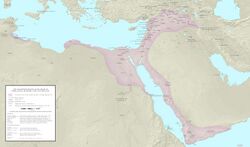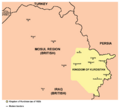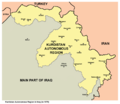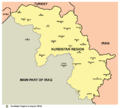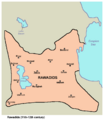Place:List of Kurdish dynasties and countries
From HandWiki
Short description: none
This is a list of Kurdish dynasties, countries and autonomous territories. By the 10th century, the term "Kurd" did not have an ethnic connotation and referred to Iranian nomads in the region between Lake Van and Lake Urmia.[1] In Arabic medieval sources, "Kurd" referred to non-Persian and non-Turkish nomads and semi-nomads (see Origin of the Kurds).[2][3]
Early entities
- Sadakiyans (770-827)
- Daysam (938–955)[4]
- Hadhabanis (906–1080)
- Aishanids (912–961)[5]
- Shaddadids (951–1199)[6]
- Rawwadids (955–1071)
- Hasanwayhids (959–1014)[7]
- Marwanids (983–1096)[6]
- Annazids (990/91[8][9]–1117)[10]
- Shabankara (11th century–12th century)[11][12]
- Principality of Eğil (1049–1864, Diyarbakir)[13]
- Hazaraspids (1115–1425)
- Ayyubid dynasty (1171–1341)[14]
- Principality of Bitlis (1187–1847)
- Vassaldom of Ardalan (14th century[15]–1865 or 1868[16][17])
- Zakarids (1161–1360)[18][19][20]
- Emirate of Çemişgezek (13th century–1663)[21]
- Mukriyan (14th century–19th century)[22]
- Zarrinnaal Dynasty (1448–1925)
- Emirate of Pazooka (1499–1587)[23]
- Principality of Suleyman[24] (15th century–1838)
- Emirate of Soran (before 1514[25]–1836[26])
- Emirate of Miks (?–1846)[27]
Remnants of the Ayyubid Dynasty (13th century–19th century)
Various Kurdish political entities blossomed in the period after the disestablishment of the Ayyubid dynasty in 1260. Some of these rulers claimed descent from the Ayyubids.
- Principality of Donboli (1210–1799)[28]
- Emirate of Bingöl (1231–1864)[29]
- Emirate of Hasankeyf (1232[29]–1524[29])
- Emirate of Kilis[30]
- Emirate of Şirvan (?–1840s)[31]
- Emirate of Hakkâri (?–1845)[32]
- Principality of Zirqan (1335–1835)
- Emirate of Bahdinan (1339[33]–1843[34])
- Emirate of Bohtan (?–1833)[34]
- Principality of Mahmudi (1406–1839)[35]
- Principality of Pinyaşi (1548–1823)[36]
Buffer zones between the Ottomans and Persia (13th century–19th century)
For various reasons, Kurdish entities existed as buffer zones between the Ottoman Empire and Persia throughout history. These include:
- Khoy Khanate (1210–1799)
- Emirate of Palu (1495–1845)[37]
- Emirate of Bradost (1510–1609)[38]
- Baban (16th century–1850)[39]
- Tabriz Khanate (1757–1799)[40]
- Hasan Khan dynasty in Pish-e Kuh (1795–1820)[41]
- Sarab Khanate (18th century)[40]
Other dynasties of Kurdish ancestry
- Safavid dynasty (1501–1736) – The dynasty was partly of Kurdish origin.[42][43][44]
- Zand dynasty (1750-1794) – The dynasty is of Kurdish Lak origin.[45][46]
20th-21st century entities
- Kurdish State (1918–1919)
- Kingdom of Kurdistan (1921–1924 and 1925)
- Kurdistansky Uyezd (1923–1929) and Kurdistan Okrug (1930)
- Republic of Ararat (1927–1931)
- Republic of Mahabad (1946–1947)
- Republic of Laçin (1992)[47]
- Islamic Emirate of Byara (2001–2003)
Current entities
- Kurdistan Region (autonomous region in Iraq, 1970–present)
- Autonomous Administration of North and East Syria (self-proclaimed autonomous region declared during the Syrian Civil War by the PYD) (2012–present)
Gallery
See also
- Kurdish emirates
- Kurdistan Eyalet
- House of Kayus
- Corduene
Bibliography
- Aboona, Hirmis (2008), Assyrians, Kurds, and Ottomans: Intercommunal Relations on the Periphery of the Ottoman Empire, Cambria Press, ISBN 9781604975833
- Baluken, Yusuf (2017) (in ku), Çend Dokument ji Serdema Mîrektiya Melkîşî, 7, Jimar, https://dergipark.org.tr/en/download/article-file/685765
- Amoretti, Biancamaria Scarcia; Matthee, Rudi (2009). "Ṣafavid Dynasty". in Esposito, John L.. The Oxford Encyclopedia of the Islamic World. Oxford University Press. "Of Kurdish ancestry, the Ṣafavids started as a Sunnī mystical order (...)".
- Matthee, Rudi (2005). The Pursuit of Pleasure: Drugs and Stimulants in Iranian History, 1500-1900. Princeton University Press. pp. 18. "The Safavids, as Iranians of Kurdish ancestry and of nontribal background (...)"
- Matthee, Rudi (2008). "SAFAVID DYNASTY". Encyclopædia Iranica. "As Persians of Kurdish ancestry and of a non-tribal background, the Safavids (...)".
- Savory, Roger (2008). "EBN BAZZĀZ". Encyclopædia Iranica. VIII. Fasc. 1.. p. 8. "This official version contains textual changes designed to obscure the Kurdish origins of the Safavid family and to vindicate their claim to descent from the Imams.".
- Başçı, Veysel (2019), "Dunbulî Beyliği Tarihi ve Tarihi Kronikleri [XIII-XVIII. YY."] (in tr), Kadim Akademi SBD 3 (2): 63–114, https://dergipark.org.tr/tr/download/article-file/914281, retrieved 28 May 2020
- Behn, W. (1988), BĀBĀN, III, 3
- Büchner, V. F. (2012), "S̲h̲abānkāra", Encyclopaedia of Islam (Brill Publishers), doi:10.1163/2214-871X_ei1_SIM_5253, ISBN 9789004082656, https://referenceworks.brillonline.com/entries/encyclopaedia-of-islam-1/shabankara-SIM_5253?s.num=4&s.rows=50
- Dehqan, Mustafa; Genç, Vural (2019), "The Kurdish Emirate of Brādōst, 1510-1609", Oriente Moderno 99 (3): 306–320, doi:10.1163/22138617-12340222, https://brill.com/view/journals/ormo/99/3/article-p306_4.xml, retrieved 30 January 2021
- The Impact of Architectural Identity on Nation Branding: The Case Study of Iraqi Kurdistan., Manchester Metropolitan University's Research Repository, 2013, https://e-space.mmu.ac.uk/326242/1/Sharameen%20Ebraheem%2007977278%20phd%202013-1.pdf
- "The Kurdish emirates", Routledge Handbook on the Kurds, Routledge Handbooks Online, 2018, pp. 35–47, doi:10.4324/9781315627427-4, ISBN 978-1-138-64664-3, https://www.routledgehandbooks.com/doi/10.4324/9781315627427-4#sec3_3_1, retrieved 1 May 2020
- Flynn, Thomas O. (2017), The Western Christian Presence in the Russias and Qājār Persia, c.1760–c.1870, Brill Publishers, ISBN 9789004313545
- The Emergence of Kurdism with Special Reference to the Three Kurdish Emirates within the Ottoman Empire, 1800-1850, University of Exeter, 2011, https://ore.exeter.ac.uk/repository/bitstream/handle/10036/3676/GhalibS.pdf?sequence=1&isAllowed=y, retrieved 1 May 2020
- Gunter, Michael M. (2010), Historical Dictionary of the Kurds, Scarecrow Press, ISBN 9780810875074
- Hakan, Sinan (2002) (in tr), Müküs Kürt Mirleri Tarihi ve Han Mahmud, Pêrî Yayınları, ISBN 9789758245581
- Houtsma, M. Th. (1993), E. J. Brill's First Encyclopaedia of Islam, 1913-1936, Brill Publishers
- Kaplan, Yaşar (2015) (in tr), Pınyanış Hükümeti/Government of Pinyanish, Hakkari University
- Maisel, Sebastian (2018), The Kurds: An Encyclopedia of Life, Culture, and Society, ABC-CLIO, ISBN 978-1-4408-4257-3
- Meinecke, Michael (1996), Patterns of Stylistic Changes in Islamic Architecture: Local Traditions Versus Migrating Artists, NYU Press, ISBN 9780814754924
- Petrushevsky, Ilya Pavlovich (1949) (in ru), Очерки по истории феодальных отношений в Азербайджане и Армении в XVI-начале XIX вв, Saint Petersburg State University
- Soyudoğan, Muhsin (2015), Tribal Bandistry in Ottoman Ayntab (1690-1730), Bilkent University
- Spuler, B. (2012), "Faḍlawayh", Encyclopaedia of Islam (Brill Publishers), doi:10.1163/1573-3912_islam_SIM_2233, ISBN 9789004161214, https://referenceworks.brillonline.com/entries/encyclopaedia-of-islam-2/fadlawayh-SIM_2233
- Top, Mehmet (1998), "Hoşaptaki Mahmudi Beylerine Ait Mimari Eserler" (in tr), Academia SBD 3 (2), https://www.academia.edu/21786613
- Verheij, Jelle (30 March 2018), ""The year of the firman:" The 1895 massacres in Hizan and Şirvan (Bitlis vilayet)", Études arméniennes contemporaines (10): 125–159, doi:10.4000/eac.1495, ISSN 2269-5281, https://journals.openedition.org/eac/1495?lang=en, retrieved 24 May 2020
- Ünal, Mehmet Ali (1999) (in tr), XVI. yüzyılda Çemişgezek sancağı
- Peacock, Andrew (2017). "RAWWADIDS". Encyclopædia Iranica. "RAWWADIDS [...] a family of Arab descent [...] Their Kurdicized descendants ruled over Azerbaijan and parts of Armenia in the second half of the 10th and much of the 11th century.".
References
- ↑ van Bruinessen, Martin (1989). A. Andrews, Peter. ed. "The ethnic identity of the Kurds". Ethnic Groups in the Republic of Turkey: 5.
- ↑ Limbert, John (1968). "The Origins and Appearance of the Kurds in Pre-Islamic Iran". Iranian Studies 1 (2): 48. doi:10.1080/00210866808701350. https://www.jstor.org/stable/4309997.
- ↑ James, Boris (September 2006). "Uses and Values of the Term Kurd in Arabic Medieval Literary Sources". https://www.institutkurde.org/en/conferences/kurdish_studies_irbil_2006/Boris+JAMES.html.
- ↑ Bosworth (1994). "Daysam". Iranica Online. https://www.iranicaonline.org/articles/daysam.
- ↑ Tor, D.G. (2017). The Abbasid and Carolingian Empires: Studies in Civilizational Formation. Brill Academic Pub. p. 54-55.
- ↑ 6.0 6.1 Amir Hassanpour, Nationalism and Language in Kurdistan, 1918-1985, Mellen Research University Press, 1992, p. 50.
- ↑ Gunter (2010), p. 117.
- ↑ Aḥmad, K. M. (1985). "ʿANNAZIDS". Iranica Online II. https://iranicaonline.org/articles/annazids-banu-annaz-a-kurdish-dynasty-r.
- ↑ Template:Encyclopaedia Islamica
- ↑ Aḥmad, K. M. (1985). "ʿANNAZIDS". Iranica Online II. https://iranicaonline.org/articles/annazids-banu-annaz-a-kurdish-dynasty-r.
- ↑ Büchner 2012.
- ↑ Spuler 2012.
- ↑ Han, Şeref (Çev. İbrahim Sunkur) (2016). Şerefname. Van: Sîtav. p. 204. ISBN 978-605-66520-1-1.
- ↑ R. S. Humphreys, Ayyubids, "Encyclopaedia Iranica", (August 18, 2011),[1]
- ↑ Oberling, P.. "BANĪ ARDALĀN". http://www.iranicaonline.org/articles/bani-ardalan-a-kurdish-tribe-of-northwestern-iran-now-dispersed-in-sanandaj-senna-and-surrounding-villages.
- ↑ David Mcdowall (1996). The Kurds. Minority Rights Group International Report. p. 20. http://bnk.institutkurde.org/images/pdf/FR5LWJGXKM.pdf. Retrieved 2 May 2020.
- ↑ Najat Abdulla-Ali (2006) (in fr). Empire, frontière et tribu Le Kurdistan et le conflit de frontière turco-persan (1843-1932). p. 159.
- ↑ Alexei Lidov, 1991, The mural paintings of Akhtala, p. 14, Nauka Publishers, Central Dept. of Oriental Literature, University of Michigan, ISBN:5-02-017569-2, ISBN:978-5-02-017569-3, It is clear from the account of these Armenian historians that Ivane's great grandfather broke away from the Kurdish tribe of Babir
- ↑ Vladimir Minorsky, 1953, Studies in Caucasian History, p. 102, CUP Archive, ISBN:0-521-05735-3, ISBN:978-0-521-05735-6, According to a tradition which has every reason to be true, their ancestors were Mesopotamian Kurds of the tribe (xel) Babirakan.
- ↑ Richard Barrie Dobson, 2000, Encyclopedia of the Middle Ages: A-J, p. 107, Editions du Cerf, University of Michigan, ISBN:0-227-67931-8, ISBN:978-0-227-67931-9, under the Christianized Kurdish dynasty of Zak'arids they tried to re-establish nazarar system...
- ↑ Ünal (1999), pp. 262–263.
- ↑ Hassanpour, Amir (1989). "BŪKĀN". Encyclopedia Iranica IV. https://iranicaonline.org/articles/bukan-kurd.
- ↑ Han, Şeref (Çev. İbrahim Sunkur) (2016). Şerefname. Van: Sîtav. p. 375. ISBN 978-605-66520-1-1.
- ↑ Houtsma (1993), p. 1144-1445.
- ↑ Ghalib (2011), p. 50.
- ↑ Ebraheem (2013), p. 235.
- ↑ Hakan (2002).
- ↑ Başçı (2019), p. 63.
- ↑ 29.0 29.1 29.2 Maisel (2018), p. 131.
- ↑ Soyudoğan (2015).
- ↑ Verheij (2018).
- ↑ Flynn (2017), p. 663.
- ↑ Aboona (2008), p. 175.
- ↑ 34.0 34.1 Eppel (2018), p. 42.
- ↑ Top (1998), p. 6-9.
- ↑ Kaplan (2015), p. 4.
- ↑ Nusret Aydın, Diyarbakır and Mirdasiler History, 2011, p. 304-305
- ↑ Dehqan & Genç (2019).
- ↑ Behn (1988).
- ↑ 40.0 40.1 Tapper, Richard (2010). "Shahsevan". Encyclopedia Iranica. https://iranicaonline.org/articles/shahsevan.
- ↑ Dehqn, Mustafa (2009). "Arkawāzī and His Baweyaļ: A Feylî Elegiac Verse from Piştiku". Iranian Studies 42 (3): 409–422. doi:10.1080/00210860902907362. https://www.jstor.org/stable/25597563.
- ↑ Matthee 2005, p. 17; Matthee 2008.
- ↑ Amoretti & Matthee 2009.
- ↑ Savory 2008, p. 8.
- ↑ Perry, John. "ZAND DYNASTY" (in en). Encyclopædia Iranica. http://www.iranicaonline.org/articles/zand-dynasty. "The founder of the dynasty was Moḥammad Karim Khan b. Ināq Khan (...) of the Bagala branch of the Zand, a pastoral tribe of the Lak branch of Lors (perhaps originally Kurds; see Minorsky, p. 616) (...)"
- ↑ ...the bulk of the evidence points to their being one of the northern Lur or Lak tribes, who may originally have been immigrants of Kurdish origin., Peter Avery, William Bayne Fisher, Gavin Hambly, Charles Melville (ed.), The Cambridge History of Iran: From Nadir Shah to the Islamic Republic, Cambridge University Press, 1991, ISBN:978-0-521-20095-0, p. 64.
- ↑ Kemper, Michael; Conermann, Stephan (2011). The Heritage of Soviet Oriental Studies. Routledge. pp. 92. ISBN 978-1-136-83854-5. https://books.google.com/books?id=QYmsAgAAQBAJ&dq=%22Republic+of+La%C3%A7in%22&pg=PA92. "In 1992 the area of Laçin was occupied by Armeian forces; a "Kurdish Republic of Laçin" was subsequently declared by local Kurds, but this remained a rather short-lived - not to say stillborn - adventure"
External links
- Historical map: Kurdish states in 1835
- Historical map: Kurdish political enclaves and territorial demands, 1919-98
